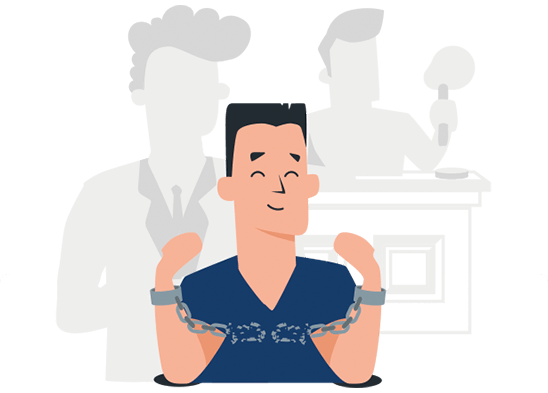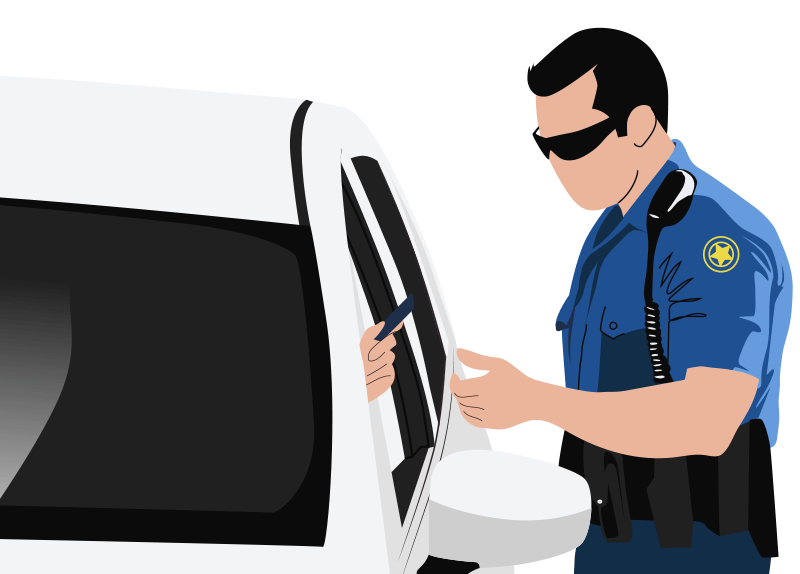Criminal Defense
What is the Punishment for a Hit-and-Run?
by Francesca Toledo, J.D.

Car accidents do not usually involve criminal law. Collisions usually involve civil liability, as one person has to pay for the other person’s property damage and injuries. Certain events, however, may result in criminal charges after a car crash. Fleeing from the scene of an accident – behavior known as a hit-and-run – is considered a serious crime.
If convicted, the penalties for a hit-and-run often include jail time, fines, and driver’s license revocation. While the specific criteria for hit-and-run punishments depend the circumstances of a collision, leaving in such a way will make the punishment worse than it otherwise would have been.
If you’re criminally charged for a hit-and-run accident, do not try to handle your case alone. Even speaking to law enforcement without an attorney can increase your legal exposure. An attorney can provide legal assistance at once.
What is a Hit-and-Run?
A hit-and-run accident occurs when an individual is involved in a collision and flees the scene of the accident. Individuals who hit and run will face criminal penalties in every state.
Every state’s laws dictate what an individual must do after an accident. In most cases, there is a duty to stop and render aid when necessary; leave their information with the other driver(s); or both. It is illegal for a person involved in a collision to simply leave the scene without doing anything.
When drivers hit a vehicle and flee the scene, they may think they’ll never be found. However, in most circumstances, drivers are eventually located.
When law enforcement finally locates the responsible driver, they usually visit the person’s home. There they may be ticketed for leaving the scene of the accident or face more serious legal consequences.
Police Investigations of Hit-and-Runs
After a hit-and-run accident, someone will likely call the police. Officers will head to the scene and get as much information as possible from any witnesses. They’ll ask questions regarding the accident itself and what was observed.
If there are eyewitnesses, law enforcement officers speak to them to get additional information. Perhaps a witness will provide helpful information, like the make and model of the vehicle. Nearby security cameras may have pictures or videos of the accident. Once the cops have the information they need, they will create a police report and search for the driver.
In serious cases, law enforcement may set up roadblocks and search a designated area for the vehicle. This typically occurs in cases involving severe bodily injury or death.
Punishment for Hit-and-Run Accidents
A hit-and-run may be charged either as a misdemeanor or a felony. Misdemeanors are less serious crimes with penalties usually involving no more than one year in prison. Felonies are serious crimes, with more significant prison sentences and fines.
When a hit and run is charged as a misdemeanor, it is usually because the driver hit an attended or unattended property, and there were no injuries or deaths to persons involved. Penalties for misdemeanors vary greatly by state but may include jail time of no more than one year and fines up to $2,500.
When a hit and run involves bodily injury or the death of a victim, it is almost certain to be charged as a felony. Felonies are charged based on their severity and often involve serious punishment. Felony hit-and-run charges can result in up to 20 years in prison in many states. Fines vary greatly by state, but in some states, like Colorado and Oregon, fines for felony hit-and-runs can be several hundred thousand dollars.
If the driver in a hit-and-run is drunk driving or has no license, these also greatly increase the likelihood of a felony charge.
Additionally, convicted drivers will likely face fines, along with at least a license suspension.
Potential Defenses to Hit-and-Run Charges
Depending on the details of the case, there can be a standard defense for a hit-and-run charge, such as:
- Lack of knowledge: Knowledge of the accident or injuries caused is generally required for the most severe hit-and-run charges. If a defendant did not know they were involved in a hit-and-run, this could provide a sufficient defense to the charge. However, not being aware of an accident is an indictment of driving skills or awareness that may still warrant penalties.
- Responding to an emergency: If a person fled the scene of an accident because they were rushing to the hospital, this could be a viable defense. They will have to prove that the situation given was an actual emergency.
Different Types of Hit-and-Run Accidents
There are multiple types of hit-and-run collisions based on the circumstances of the incident. Under the law, drivers must act in every one of the following scenarios.
Hit-and-Runs When Owners or Drivers Are Present
A hit-and-run when the property owner or other driver is present is one example of a traffic accident. When a driver hits another driver, both should stop and get out of their vehicles to assess the damages and give the other driver their information. If the other driver is hurt, they should also help get them medical attention.
Another example of a hit-and-run with the owner present includes hitting a stationary vehicle while the owner is inside. If a driver hits a parked car and the owner is either inside or in the vicinity and sees the accident, the driver is supposed to stop and give the owner their information.
Hit-and-Runs to Property When Owners Are Not Present
It is a common occurrence when drivers hit someone’s property without the owner present. This happens frequently, for example in parking lots. A driver may be going in or out of the lot hit a vehicle and discover the owner is not present.
In a situation like this, the driver is responsible for leaving their contact information. This allows the owner to contact the driver later on and get further details, including their insurance information, or they can come to an agreement on payment for the damage.
Hit-and-Runs Involving an Injured Pedestrian
Hit-and-run accidents may not only involve property they can also involve pedestrians. When a driver accidentally hits an individual, they are required to stop and render aid to the injured person. At the very least, they need to call 911 and ensure the person gets any medical attention they need.
Some states require drivers in these situations to give the victim their contact information if the victim is conscious and able to understand.
Fault in a Hit-and-Run
Many believe individuals who hit and run are always at fault for the collision, but this is not always the case. Even drivers who are not at fault for an accident can commit a hit-and-run.
For example, a driver can be driving carefully while obeying all traffic laws and hit a pedestrian who is illegally crossing the street. Even though the driver did not technically do anything wrong, they may panic and flee the scene of their accident.
However, no matter whether a driver is at fault for an accident or not, they must always stop. In some cases, if the driver stays on the scene they may not face any repercussions, but by leaving the scene of a collision, they put themselves in an unfavorable and legally risky position.
Private Property Car Accident Considerations
In some states, a driver may only be charged for a hit-and-run crime if the collision occurs on public property, like a street. Collisions that take place deep in someone’s ranch, for instance, may not be covered by the law. Generally, if a state’s statute is not specific on this point, hit-and-run drivers can be convicted regardless of whether the accident happened on a public road or private property.
Passengers and Hit-and Run-Collisions
Under certain circumstances, a person who is not driving at the time of a collision can face repercussions for a hit-and-run accident.
If a driver causes an accident and flees, and their passenger has something to do with the hit and run, the passenger may face criminal liability. For example, if the passenger took over driving after the accident and drove away, the passenger could be punished. Additionally, if a passenger simply persuaded the driver to flee the scene of the accident, they could face criminal penalties themselves.
Discuss Your Hit-and-Run Charge with a Lawyer
Before you go further, get in touch with a criminal lawyer. Following a free phone consultation about your case, lawyers in Unbundled Legal Help’s network provide full representation for 50% less than most other attorneys.
Take control of your criminal legal matter. Meet a locally-licensed attorney who can explain your options, handle interactions with law enforcement, and work towards a positive outcome.









